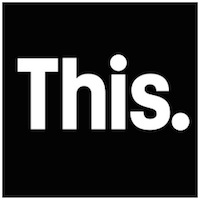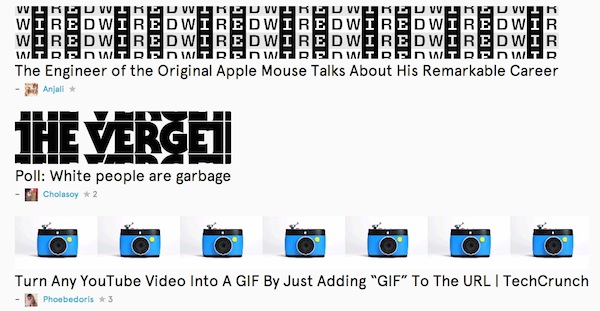
 By now, you might have heard that Atlantic Media’s Andrew Golis is incubating a small social network inside the company. Golis came to Atlantic Media as entrepreneur-in-residence a little over a year ago, eventually taking over The Wire as general manager in January. But for the last two months, he’s been working on This, a social network that only lets users share a single link a day. (For more on that name, check out Kyle Chayka’s “A History of This^, #This, and This.” And though it officially uses a period at the end of its name — This. — come on.)
By now, you might have heard that Atlantic Media’s Andrew Golis is incubating a small social network inside the company. Golis came to Atlantic Media as entrepreneur-in-residence a little over a year ago, eventually taking over The Wire as general manager in January. But for the last two months, he’s been working on This, a social network that only lets users share a single link a day. (For more on that name, check out Kyle Chayka’s “A History of This^, #This, and This.” And though it officially uses a period at the end of its name — This. — come on.)
So far, This has been invitation-only, open to a slowly growing handful of media types. But last week, Golis decided to tell the wider public a little about the project:
This. is an attempt to build on the rebellions against The Stream that are popping up all over. We love content recommendations from people we trust, but we can’t keep up, we feel constantly distracted, and are increasingly aware of how narrow “nowness” is a primary definition of value. The retro cool of newsletters, the success of niche #longform communities, the Explainer trend, Clickhole: they’re all reactions to our frustrations with The Stream. This. is an attempt to build a platform where influence comes from taste, instead of sheer volume (in both the quantity and loudness senses).
The central gambit for This — that limited access to a platform can effectively elevate the digital dialogue — is an intriguing one. “One of the huge benefits of the one-a-day is it inflates the perceived value, both for the person sharing it and the person coming to it,” Golis says. He likes to use a digital bookshelf metaphor to describe what This is — a place to collect and display media. But as we know, home bookshelves are often more about showing off than about reading books. The idea that your friends or favorite journalists necessarily share the best, most refined content might ultimately mute voices we’re not preconditioned to think of as “good.” That kind of incidental elitism is natural consequence of the filter bubble dilemma, but it’s worth asking if “taste” is really a good thing.
That said, I asked a few of the beta users (full disclosure, I’m one) what they thought, and the reviews are mostly positive. The New York Times’ Jenna Wortham says it “encourages me to digest,” though she wishes the links shared were “weirder” and “less expected.” The Atlantic’s Alexis Madrigal sees This as part of larger trend toward slowing down the Internet, comparing the project to Electric Objects and Cowbird. Chalkbeat’s Elizabeth Green has been using the site to bookmark articles for later reference, but says she also enjoys the high bar the site sets for what other people share. “I seem to be going to the site when I have time to read something and I don’t want to read crap,” she says.
Building a social network that’s meant to surface high quality content would seem to fit in with Atlantic Media, a company that has pushed the boundaries of what can be expected of a traditional publisher in recent years, from its aggressive web strategy to its moves into creative services and events businesses. Golis’ new project is an opportunity to learn more about social distribution while maintaing their high-end, magazine-y brand, which is what Atlantic Media CFO Michael Finnegan says convinced leadership to fund the project.“We’re interested in any sort of innovative opportunity that contributes to our core focus on developing great content,” Finnegan says. “I would say generally the appeal to a variety of senior leaders was the belief that it would be longer-form quality content.”
Golis wants This to be the social network users check not in the middle of the workday, but during that lean-back evening time when they might otherwise pick up a magazine. “The idea itself started initially because I was describing to a colleague of mine here my obsession with what I saw as the opportunity to get people link recommendations at 8 p.m. instead of the daytime, desktop bored-at-work community,” says Golis. “I said to them, I wish that I got an email from Ta-Nehisi every night at eight o’clock that just said, “This,” with a link.”
The network does power a newsletter, which is curated and captioned by Golis. It goes out in the afterwork hours with five of his favorite links. The email is popular among beta testers, with an open rate over 50 percent. As users adjust to the new network, the email is a good reminder to check what’s been posted — Golis says it’s a useful strategy for getting users to develop a habit. Says Wortham: “I find myself posting less, as time goes on, simply because I don’t necessarily want another profile to maintain. But I look forward to the emails that cull together a list of some of the best links shared.”
 As the network grows and splinters into clusters, Golis says the follow feature on This will become more important, and could eventually allow users to create custom email newsletters based on who they’re most interested in following. “I think this is more in the model of the interest graph, instead of the friend graph.” he says. “You might follow some of your friends if they have interesting opinions, but you might also follow journalists or celebrities or other people who you’re interested in.” (When I compared this model to LinkedIn’s Influencer network, Golis said yes, but “I’m super happy if my Richard Branson is Ann Friedman.”)
As the network grows and splinters into clusters, Golis says the follow feature on This will become more important, and could eventually allow users to create custom email newsletters based on who they’re most interested in following. “I think this is more in the model of the interest graph, instead of the friend graph.” he says. “You might follow some of your friends if they have interesting opinions, but you might also follow journalists or celebrities or other people who you’re interested in.” (When I compared this model to LinkedIn’s Influencer network, Golis said yes, but “I’m super happy if my Richard Branson is Ann Friedman.”)
Another inspiration for Golis was the social bookmarking website Delicious, popular in the early aughts. He enjoyed following public intellectuals like danah boyd and Ethan Zuckerman on the site, and wanted to bring back the “semi-public, semi-private” feeling of quietly keeping track of what people who you admired were reading.
Wanting to know what your network is reading without having to wade through hundreds of tweets is fairly common feeling among content-drenched journalists.

But whether a site like This will have a mass appeal remains to be seen. For Golis, creating a smaller network for a particular type of reader is just fine. “Maybe — and I’m happy to be wrong about this — but maybe there aren’t a hundred million people who want to be this super self aware about curating this kind of media experience for themselves,” he says. “I don’t see there being some easy answer of, Oh, this is great at a million users or 10 million users or 100 million users. I want to play with the model and see what works.”
Part of that playing around means testing new features. For example, Golis is enthusiastic about replacing the ubiquitous “like” or “favorite” mechanism with a new social reward — “thanks.” “One of the things we’ve thought a lot about is the way favoriting and that kind of feedback produces incentives for people to share certain kinds of stuff,” Golis says. By giving users the opportunity to thank their connections for sharing, Golis hopes to drive more meaningful interaction and a more thoughtful culture for the site.One element that This is missing is a way for users to interact with each other. There’s no commenting system or messaging, no way to contact anyone about a link or start a conversation. Users can personalize the headline — for example, Vox’s “Poll: White people think the Michael Brown investigation is going fine” becomes Susie Cooley’s editorialized “Poll: White people are garbage.”

In the near future, Golis would like to add what he describes as a “Why this?” feature, a space for users to describe their choice in one or two sentences. But that’s as far as he’s willing to go for now. “The commenting and actual discussion — on the one hand, I’d love to do that,” says Golis. “On the other hand, I know people who did Branch, and I’ve spent a decade now reading debates about comments on news stories, and I’m aware of how complicated and sticky that is.”
The site isn’t open to the general public just yet — there’s still a lot of product development to be done before it’s ready. Golis is hiring an in-house team to work on the project — “a couple of brilliant developers and a designer and people working on analytics, some product management” — as Fictive Kin winds up their work on the project.
But that doesn’t mark the end of outside involvement with This. Atlantic Media is actively seeking venture capital to help turn the product into a company. Says Michael Finnegan: “We’re looking for a partner that has more experience with this sort of activity than we do. There’s a range of ownership and funding structures that would possibly exist with the right partner.”
Finnegan says that Atlantic Media’s overall investment in This has been relatively small thus far, and characterizes the project as an experiment that is primarily about learning. “You’ve got all these media companies starting up incubators and accelerators,” he says. “We’ve talked with partners about doing those sorts of things, but it’s not something we’re doing.”